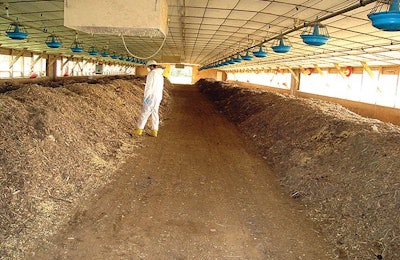
No poultry farm is immune to an avian influenza outbreak, therefore, having a plan to deal with such a situation is crucial, explained Dr. Charles Hatcher, state veterinarian with the Tennessee Department of Agriculture at the 2017 Live Production and Welfare Seminar in Nashville, Tennessee.
“You can never do too much planning,” Hatcher said.
A lapse in biosecurity practices is the most likely way for viruses to enter the house. Each premise must have its own site-specific plan and conduct internal audits of facilities and their practices regularly. The state of Tennessee will be requiring producers to have a National Poultry Improvement Plan (NPIP) compliant biosecurity plan by the end of October 2017.
The southern outbreak
Tennessee's first case of a highly pathogenic strain of H7N9 avian influenza was announced on March 5, and it affected a broiler breeder flock in Lincoln County. A flock of chickens at a commercial broiler breeder operation in Giles County, Tennessee, tested positive for low pathogenic H7N9 avian influenza. The state’s second avian influenza case in 2017 was confirmed on March 8.
On March 14, the Alabama Department of Agriculture and Industries (ADAI) issued a stop movement order for certain poultry in the state, after three potential cases of avian influenza were identified. It halted movement of birds to poultry shows, swap meets, flea markets and poultry auctions.
The possible infections occurred in three north Alabama counties that border Tennessee, where the two cases of avian influenza were previously confirmed. These cases were a backyard flock of layers, a commercial broiler breeder flock and a backyard flock of guinea fowl, which were confirmed as positive for low pathogenic avian flu on March 10, 14 and 15, respectively.
In Alabama on March 16 and 17, cases of a low pathogenic strain of the disease were confirmed in a commercial poultry breeding operation in Pickens County and a backyard flock in Madison County. Both detections were not related to highly pathogenic avian influenza (HPAI) detections elsewhere in the country. On March 22, the department confirmed another low pathogenic case in a commercial broiler breeder flock in Cullman County.
A press release from ADAI said the commercial flocks were under quarantine.
In total, there were eight commercial broiler breeder farms impacted during the southern outbreak. These operations were spread out among four states, including Georgia, Kentucky, Tennessee and Alabama. Those outbreaks dealt with six different companies. Approximately 252,000 birds died from the disease or from depopulation in hopes of controlling further outbreak, according to the Epidemiologic and Other Analyses of HPAI/LPAI Affected Poultry Flocks report released by the United States Department of Agriculture in June 2017.
Planning methods and processes
Rapid detection, notification and depopulation remains critical in stopping the spread of disease. “Depopulate within 24 hours of detection; we were able to do this by foaming,” said Hatcher when discussing his idea of disease control goals.
Dr. Kate Hayes with Aviagen discussed lessons learned from avian influenza from her experience with the Tennessee outbreaks at the same conference in Nashville. After the experience with foam she implied foaming will not be their method again should the disease become a problem for the company. She said it was challenging to clean up in housing systems with concrete flooring.
Hatcher noted that he would consider carbon dioxide to depopulate if need be.
The fact that broiler breeders were involved in this outbreak is significant when considering the efficacy of using foam for euthanasia. Foam seems to work well when the floor is flat and the birds are all on one level, but not so well if there are multiple levels for the birds to inhabit or if it is below freezing out.
Hatcher said there are only two real options for disposing of the birds, onsite burial or composting.
“We did onsite burial this time but that wasn’t without issues,” he said.
Hatcher would like to do composting only. Preferably in the house or under cover, he added. The disposal method will be preapproved by the state before the next outbreak.
When going through suggestions for producers’ individual planning processes, Hatcher suggested that Emergency Resources Management System (ERMS) coupled with the new Gateway is the way to go.
“Preloading premises numbers ahead of an outbreak is a must,” he said.
These numbers are used for tracking lab results. If this isn’t done it could slow down producers’ whole process of verification and depopulation as needed, potentially by a couple days even.
Proper surveillance is also crucial, Hayes noted. “Emergency surveillance samples were collected in one day and test results completed within 48 hours,” she said. Hatcher suggested increasing testing during time of high risk.
Preparing for an outbreak of Avian Influenza
Hayes suggests making sure equipment and supplies are ready to go should an outbreak occur. A plan might include having a mobile response trailer, mobile shower and restroom trailer for burial sites, she added. Keep inventory of your supplies too. Know what kind of equipment you will need at each site and have it readily available.
It is also important to monitor employee health and fatigue when managing these situations.
“Collaborate and communicate,” Hatcher said. Make sure everyone understands how to follow the plan before actions need to take place. “Trained and experienced strike teams for depopulation and disposal would be nice.”
Producers should make decisions based on high risk or worst case scenario situations.
“Use your common sense,” Hatcher said.
He asked to help with future planning and management practices by support funding for state and federal disease prevention and control efforts.

















